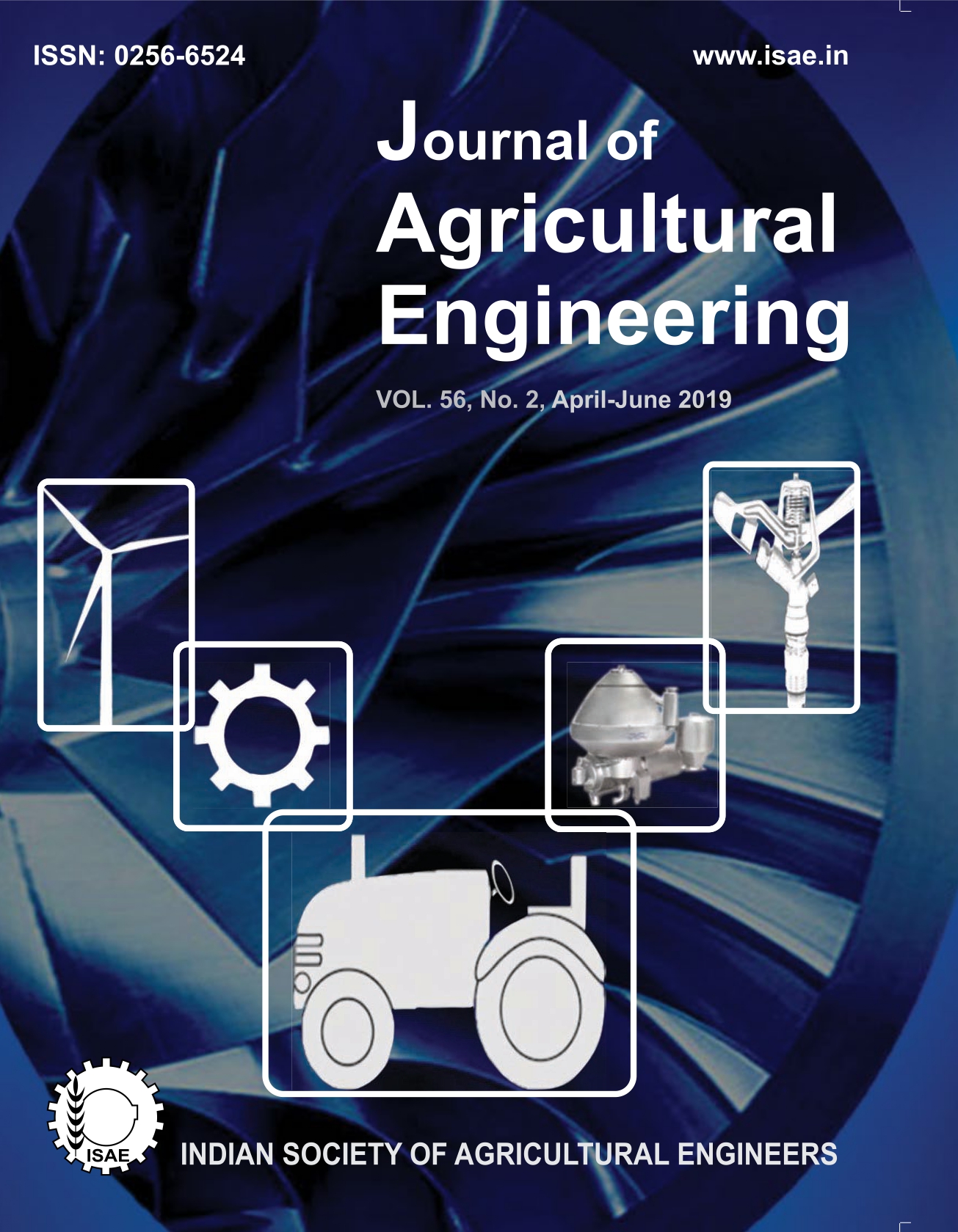Hybrid Greenhouse Dryer for Paddy
DOI:
https://doi.org/10.52151/jae2019562.1683Keywords:
Greenhouse drying, paddy drying, photovoltaic, solar dryerAbstract
A forced convection greenhouse dryer was developed and used for drying of freshly harvested paddy. The solar greenhouse dryer of size 4.47 × 2.13 m with 2.59 m central height was constructed and covered with 6 mm polycarbonates sheet. Photovoltaic power driven direct current fans were used to provide forced ventilation. Freshly harvested paddy was dried at 50, 100 and 150 mm bed thickness in the hybrid greenhouse dryer and open sun drying during kharif and rabi seasons of 2016. The kharif harvested paddy was dried from 25.3 % to 12.0 % (w.b.) moisture content at 100 mm bed thickness within 21 h, 28 h of drying in the hybrid greenhouse dryer and open sun drying, respectively. Highest drying rates were 1.54 kg.h-1 and 1.35 kg.h-1 in greenhouse dryer and open sun drying, respectively. During rabi season, paddy was dried from 22.8 % to 12.0 % (w.b.) moisture content within 19 h and 25 h with highest drying rates of 1.65 kg.h-1 and 0.97 kg.h-1, respectively, in the hybrid greenhouse dryer and open sun drying. Thermal efficiency of the greenhouse dryer was 28.15 % and 22.15 %, and pickup efficiency was 15.49 % and 14.88 % during kharif and rabi seasons, respectively.
References
Abdallah S E. 2010. Thermal efficiency enhancement of a solar drier for hay making from sugar beet tops. Agric. Mech. Asia Afr. Lat. Am., 41(4), 87-98.
Aliyu A B; Jibril H. 2009. Utilization of greenhouse effect for solar drying of cassava hips. Int. J. Phys. Sci., 4 (11), 615-622.
Almuhanna E A. 2012. Utilization of a solar greenhouse as a solar dryer for drying dates under the climatic conditions of the Eastern Province of Saudi Arabia Part I: Thermal performance analysis of a solar dryer. J. Agric. Sci., 4 (3), 237-246.
Anon. 2018. Annual Report 2017-18. Department of Agriculture and Cooperation, Ministry of Agriculture, Government of India, 11-12.
AOAC. 1985. Official Methods of Analysis. Association of Official Analytical Chemists (Vol-II), Washington DC, 777-788.
Arun S; Ayyappan S; Sreenarayanan V V. 2014. Experimental and comparison studies on drying characteristics of sliced cut tomatoes and cube cut tomatoes. Int. J. Recent Technol. Eng., 3 (4), 26-31.
Barnwal P; Tiwari G N. 2010. Experimental validation of hybrid photovoltaic-thermal (PV/T) greenhouse dryer under forced mode. Int._J. Food_ Eng., 6(6), 1-27.
Boonyasri M; Lertsatitthanakorn C; Wiset L; Poomsa-ad N. 2012. Performance analysis and economic evaluation of a greenhouse dryer for pork drying. KKU Eng. J., 38, 433-442.
EREC. 2013. Energy Efficiency and Renewable Energy Cleaning House. Agricultural Applications of Solar Energy, United State Department of Energy. http://infohouse.p2ric.org/ref/24/23989.htm. Date of accession: 02.10.2018.
Fudholi A; Othman M Y; Ruslan M H; Sopian K. 2013. Drying of malaysian capsicum annuum L. (Red Chili) dried by open and solar drying. Int. J. Photoenergy, 1-9.
Hii C L; Rahman A R; Jinap S; Man Y C. 2006. Quality of cocoa beans dried using a direct solar dryer at different loadings. J. Sci. Food Agric., 86, 1237-1243.
Jain D; Tiwari G N. 2003. Thermal aspects of open sun drying of various crops. Energy, 28, 37-54.
Janjai S; Lamlert N; Intawee P; Mahayothee B; Bala B K; Nagle M; Muller J. 2009. Experimental and simulated performance of a PV-ventilated solar greenhouse dryer for drying of peeled longan and banana. Sol. Energy, 83(9), 1550-1565.
Manikantan M R; Barnwal P; Goyal R K. 2014. Drying characteristics of paddy in an integrated dryer. J. Food Sci. Technol., 51(4), 813-819.
Mekhilefa S; Saidurb R; Safari A. 2011. A review on solar energy use in industries. Renewable Sustainable Energy Rev., 15, 1777-1790.
NYSERDA. 2009. Introduction to Solar Energy Applications for Agriculture. New York State Energy Research Development Authority, New York. http://www.matchinggrants.org/global/pdf/doc122-87.pdf. Date of accession: 2.10.2018.
Salvatierra-Rojas A; Nagle M; Gummert M; de Bruin T; Müller J. 2017. Development of an inflatable solar dryer for improved postharvest handling of paddy rice in humid climates. Int. J. Agric. Biol. Eng., 10(3), 269-282.
Senadeera W; Kalugalage I. 2004. Performance evaluation of an affordable solar dryer for crops. In: Biennial Conference of the Society of Engineers in Agriculture, 14-16 September, Dubbo, Australia,1-7.
SimateI N; Cherotich Sam. 2017. Design and testing of a natural convection solar tunnel dryer for mango. J. Sol. Energy, 2017, 1-10.
Svejkovsky C. 2006. Renewable Energy Opportunities on the Farm. ATTRO National Sustainable Agriculture Information Service, U.S.A. https://attra.ncat.org/attra-pub/download.php? id=306. Date of accession: 02.10.2018.
Xingxing Z; Xudong Z; Stefan S; Jihuan X; Xiaotong Y. 2012. Review of R&D progress and practical application of the solar photovoltaic/thermal (PV/T) technologies. Renewable Sustainable Energy Rev., 16, 599-617.














